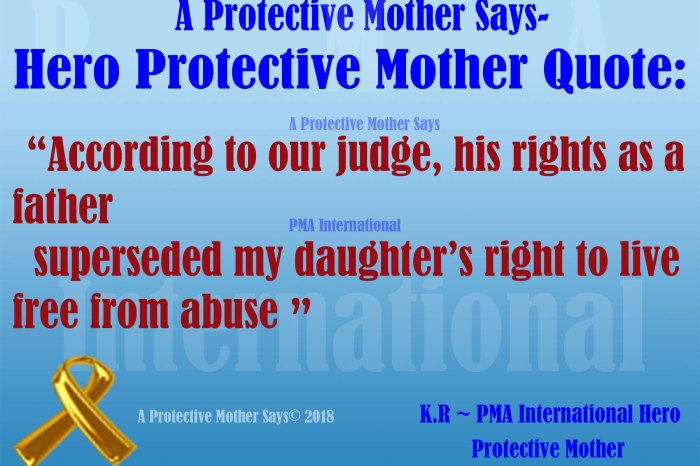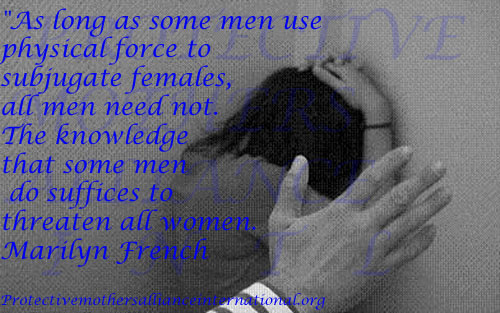Posts Tagged ‘violence’
A Protective Mother Says/ Hero Protective Mother Quotes
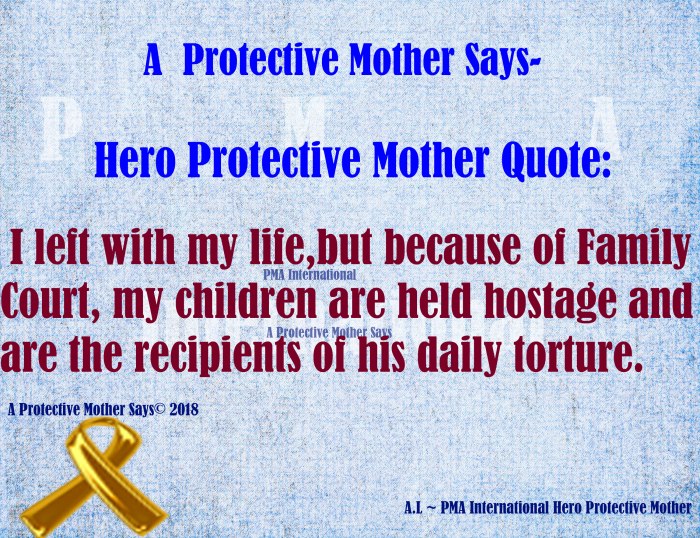
A new PMA International campaign- A Protective Mother Says/Hero Protective Mother Quotes. To participate you may send your quote to the comment section of this website/blog. Only your initials will be used( unless you otherwise request different initials) . We reserved the right to edit all comments/quotes. As always your privacy will be respected. We value your participation. Much love and respect ![]()
Judged Sexually Promiscuous, Presumed Not Raped- Lost Custody Of My Child ( Photography and Quote)/ Unstoppable Mothers
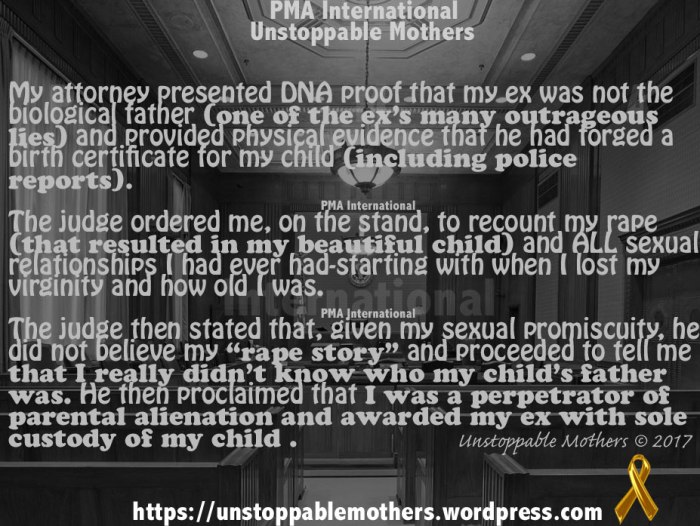
#1 The most outrageous action a judge took in your family court case
“My attorney presented DNA proof that my ex was not the biological father (one of the ex’s many outrageous lies) and provided physical evidence that he had forged a birth certificate for my child (including police reports). The judge ordered me, on the stand, to recount my rape (that resulted in my beautiful child) and ALL sexual relationships I had ever had-starting with when I lost my virginity and how old I was.
The judge then stated that, given my sexual promiscuity, he did not believe my “rape story” and proceeded to tell me that I really didn’t know who my
child’s father was. He then proclaimed that I was a perpetrator of parental alienation and awarded my ex with sole custody of my child.”
Unstoppable Mothers © 2017

PMA International- Hero Protective Moms
Protective Mothers are Heroes. You have our love and support, always
Wounded Healer/ The Series
Disclaimer:
All content provided for PMA International’s Wounded Healer series is for informational purposes only. This content does not represent the PMA International organization as a whole or its members/supporters, state chapter leaders, international leaders, administrators, professional supporters and co-founders. PMA International makes no representations as to the accuracy or completeness of any information in the Wounded Healer series or found by following any link in the Wounded Healer Series. The responsibility is yours alone on how this information is used. IN NO EVENT SHALL PMA International BE LIABLE FOR ANY DIRECT, INDIRECT, INCIDENTAL, PUNITIVE, OR CONSEQUENTIAL DAMAGES OF ANY KIND WITH RESPECT TO THE informational material on the site.

What is a Wounded Healer?
A Wounded Healer is someone volunteering or working in the healing profession who is helping others but bleeding from their own wounds while they help.
According to Carl Jung the psychiatrist; a wounded healer must go through their wound. He explains that To go through our wound is to embrace and say “yes” to the mysteriously painful new place in ourselves where the wound is leading us. Going through our wound, we can allow ourselves to be re-created by the wound. Our wound is not a static entity, but rather a continually unfolding dynamic process that manifests, reveals and incarnates itself through us, which is to say that our wound is teaching us something about ourselves. Going through our wound means realizing we will never again be the same when we get to the other side of this initiatory process. Going through our wound is a genuine death experience, as our old self “dies” in the process, while a new, more expansive and empowered part of ourselves is potentially born (Wikipedia).
http://en.wikipedia.org/wiki/Wounded_healer
Wounded Healer; The Series/ Part 5
The Alexander Technique
In this part of the Wounded Healer, we explore the Alexander Technique as it applies to PTSD, anxiety, and stress
What is the Alexander Technique?
“The Alexander technique is a way of learning how you can get rid of harmful tension in your body.” Although not a full definition of the Alexander Technique, this is a good start.*
“The Alexander Technique is a way of learning to move mindfully through life. The Alexander process shines a light on inefficient habits of movement and patterns of accumulated tension, which interferes with our innate ability to move easily and according to how we are designed. It’s a simple yet powerful approach that offers the opportunity to take charge of one’s own learning and healing process because it’s not a series of passive treatments but an active exploration that changes the way one thinks and responds in activity. It produces a skill set that can be applied in every situation. Lessons leave one feeling lighter, freer, and more grounded.”
“The Alexander Technique is a method that works to change (movement) habits in our everyday activities. It is a simple and practical method for improving ease and freedom of movement, balance, support and coordination. The technique teaches the use of the appropriate amount of effort for a particular activity, giving you more energy for all your activities. It is not a series of treatments or exercises, but rather a reeducation of the mind and body. The Alexander Technique is a method which helps a person discover a new balance in the body by releasing unnecessary tension. It can be applied to sitting, lying down, standing, walking, lifting, and other daily activities…”
“The Alexander Technique is an intelligent way to solve body problems.”
– So begins an excellent article and introduction to the Technique.
To read more please visit this informative site, link below
http://www.alexandertechnique.com/at.htm
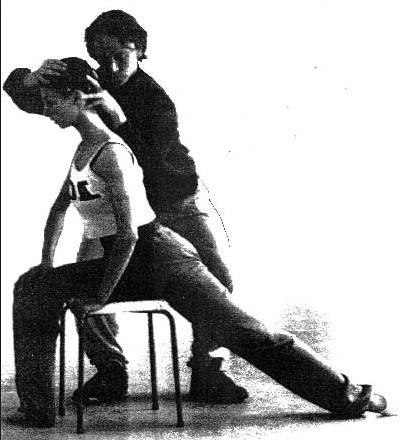
Alexander Technique online resources
Alexander On-Line
A Guide to Interactive Alexander Technique Resources on the Web
Alexander Technique Blogs and Social Media
Alexander Technique Blogs is a compilation of the very best of AT blogs from around the world, many of which are interactive.
In recent years, a number of Alexander Technique teachers and students have become active on Facebook and Twitter. You can search either Facebook or Twitter for “Alexander Technique” to see what’s available.
Here are a few suggestions:
The Complete Guide to the Alexander Technique Page on Facebook provides up-to-date information about the latest Alexander Technique developments from around the world.
Alexander Technique Global is a Facebook group for Alexander Technique teachers, students, and enthusiasts from all backgrounds.
Alexander Technique Worldwide is a Facebook group for Alexander Technique teachers and is not a public group..
Alexander Technique Blogs is a Facebook group that is a good place to see recent blog posts.
I like lying down in semi-supine is a Facebook group that lists information about and examples of Alexander Technique constructive rest.
http://www.alexandertechnique.com/at.htm
What is PTSD?
“Post-traumatic stress disorder (PTSD) is a mental health condition that’s triggered by a terrifying event — either experiencing it or witnessing it. Symptoms may include flashbacks, nightmares and severe anxiety, as well as uncontrollable thoughts about the event.
Most people who go through traumatic events may have temporary difficulty adjusting and coping, but with time and good self-care, they usually get better. If the symptoms get worse, last for months or even years, and interfere with your day-to-day functioning, you may have PTSD.
Getting effective treatment after PTSD symptoms develop can be critical to reduce symptoms and improve function.”
http://www.mayoclinic.org/diseases-conditions/post-traumatic-stress-disorder/home/ovc-20308548
What is anxiety?
Experiencing occasional anxiety is a normal part of life. However, people with anxiety disorders frequently have intense, excessive and persistent worry and fear about everyday situations. Often, anxiety disorders involve repeated episodes of sudden feelings of intense anxiety and fear or terror that reach a peak within minutes (panic attacks).
These feelings of anxiety and panic interfere with daily activities, are difficult to control, are out of proportion to the actual danger and can last a long time. You may avoid places or situations to prevent these feelings. Symptoms may start during childhood or the teen years and continue into adulthood.
Examples of anxiety disorders include generalized anxiety disorder, social anxiety disorder (social phobia), specific phobias and separation anxiety disorder. You can have more than one anxiety disorder. Sometimes anxiety results from a medical condition that needs treatment.
Whatever form of anxiety you have, treatment can help.

To learn about how the Alexander Technique can help with PTSD and anxiety. Listen to the Podcast below-
Becca Ferguson, an Alexander Technique teacher in Urbana and Chicago, Illinois talks with Robert Rickover about the role the Alexander Technique in helping people with PTSD release the physical tensions that are a part of this condition. Becca’s website: mindfulat.com Robert’s website: alexandertechniquenebraska.com More information about the Alexander Technique: alexandertechnique.comhttp://bodylearning.buzzsprout.com/382/50982-how-the-alexander-technique-can-help-people-with-post-traumatic-stress-disease-ptsd
alexandertechnique.comhttp://bodylearning.buzzsprout.com/382/50982
40 Years Later, the Mothers of Argentina’s ‘Disappeared’ Refuse to be Silent/ The Guardian
“Decades after the military murdered thousands, Mothers of Plaza de Mayo warn that the current era of alternative facts poses a new threat..
“Four decades on and 2,037 marches later, the mothers are still marching, though some of them must now use wheelchairs..
“The mothers’ white headscarves became a symbol of courage and the relentless battle for justice – and they have largely succeeded in their original aims: as of 2016, more than 1,000 of the dictatorship’s torturers and killers had been tried and 700 sentenced..
“But I couldn’t keep quiet. We needed everyone to know, even if nobody believed us. That’s probably why they called us the Mad Mothers at first,” she says.
“Of course we were mad,” Almeida says. “Mad with grief, with impotence. They took a woman’s most precious gift, her child.”
Please follow the link below to read more

What Is Stalking? / Stalking Resource Center
Below is an excerpt from the Stalking Resource Center. This site is very informative with helpful tips and valuable resources. Please visit the site for more information if you or someone you know is being stalked.
What is Stalking?
While legal definitions of stalking vary from one jurisdiction to another, a good working definition of stalking is a course of conduct directed at a specific person that would cause a reasonable person to feel fear.
Stalking is serious, often violent, and can escalate over time.
Some things stalkers do:
-
Follow you and show up wherever you are.
-
Send unwanted gifts, letters, cards, or e-mails.
-
Damage your home, car, or other property.
-
Monitor your phone calls or computer use.
-
Use technology, like hidden cameras or global positioning systems (GPS), to track where you go.
-
Drive by or hang out at your home, school, or work.
-
Threaten to hurt you, your family, friends, or pets.
-
Find out about you by using public records or online search services, hiring investigators, going through your garbage, or contacting friends, family, neighbors, or co-workers.
-
Posting information or spreading rumors about you on the Internet, in a public place, or by word of mouth.
-
Other actions that control, track, or frighten you.
You are not to blame for a stalker’s behavior.
Stalking Victimization
- 7.5 million people are stalked in one year in the United States.
- Over 85% of stalking victims are stalked by someone they know.
- 61% of female victims and 44% of male victims of stalking are stalked by a current or former intimate partner.
- 25% of female victims and 32% of male victims of stalking are stalked by an acquaintance.
- About 1 in 5 of stalking victims are stalked by a stranger.
- Persons aged 18-24 years experience the highest rate of stalking.
- 11% of stalking victims have been stalked for 5 years or more.
- 46% of stalking victims experience at least one unwanted contact per week.
[Matthew J. Breiding et al., “Prevalence and Characteristics of Sexual Violence, Stalking, and Intimate Partner Violence Victimization – National Intimate Partner and Sexual Violence Survey, United States, 2011”, Centers for Disease Control and Prevention Morbidity and Mortality Weekly Report, Vol. 63, No. 8 (2014): 7]
[Katrina Baum et al., (2009). “Stalking Victimization in the United States,” (Washington, DC:BJS, 2009).]
If you are being stalked, you may:
- Feel fear of what the stalker will do.
- Feel vulnerable, unsafe, and not know who to trust.
- Feel anxious, irritable, impatient, or on edge.
- Feel depressed, hopeless, overwhelmed, tearful, or angry.
- Feel stressed, including having trouble concentrating, sleeping, or remembering things.
- Have eating problems, such as appetite loss, forgetting to eat, or overeating.
- Have flashbacks, disturbing thoughts, feelings, or memories.
- Feel confused, frustrated, or isolated because other people don’t understand why you are afraid.
These are common reactions to being stalked.
Impact of Stalking on Victims
- 46% of stalking victims fear not knowing what will happen next. [Baum et al., (2009). “Stalking Victimization in the United States.” BJS.]
- 29% of stalking victims fear the stalking will never stop. [Baum et al.]
- 1 in 8 employed stalking victims lose time from work as a result of their victimization and more than half lose 5 days of work or more. [Baum et al.]
- 1 in 7 stalking victims move as a result of their victimization. [Baum et al.]
- The prevalence of anxiety, insomnia, social dysfunction, and severe depression is much higher among stalking victims than the general population, especially if the stalking involves being followed or having one’s property destroyed. [Eric Blauuw et al. “The Toll of Stalking,” Journal of Interpersonal Violence 17, no. 1(2002):50-63.]
Stalking and Intimate Partner Femicide*
-
76% of intimate partner femicide victims have been stalked by their intimate partner.
-
67% had been physically abused by their intimate partner.
-
89% of femicide victims who had been physically assaulted had also been stalked in the 12 months before their murder.
-
79% of abused femicide victims reported being stalked during the same period that they were abused.
-
54% of femicide victims reported stalking to police before they were killed by their stalkers.
*The murder of a woman.
[Judith McFarlane et al., “Stalking and Intimate Partner Femicide,” Homicide Studies 3, no. 4 (1999).]
Stalkers
A stalker can be someone you know well or not at all. Most have dated or been involved with the people they stalk. Most stalking cases involve men stalking women, but men do stalk men, women do stalk women, and women do stalk men.
- 2/3 of stalkers pursue their victims at least once per week, many daily, using more than one method.
- 78% of stalkers use more than one means of approach.
- Weapons are used to harm or threaten victims in 1 out of 5 cases.
- Almost 1/3 of stalkers have stalked before.
- Intimate partner stalkers frequently approach their targets, and their behaviors escalate quickly.
[Kris Mohandie et al., “The RECON Typology of Stalking: Reliability and Validity Based upon a Large Sample of North American Stalkers,” Journal of Forensic Sciences 51, no. 1 (2006).]
Stalking Laws
-
Stalking is a crime under the laws of all 50 states, the District of Columbia, the U.S. Territories, and the Federal government. Click here for a compilation of state, territory, tribal, and federal laws.
-
Less than 1/3 of states classify stalking as a felony upon first offense.
-
More than 1/2 of states classify stalking as a felony upon second offense or subsequent offense or when the crime involves aggravating factors.
-
Aggravating factors may include: possession of a deadly weapon, violation of a court order or condition of probation/parole, victim under 16 years, or same victim as prior occasions.
What Is Stalking? / Stalking Resource Center
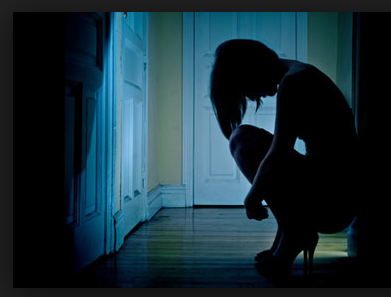
Steps to Safety After a PPO- When it’s time to escape, make sure to have a plan/ domestic shelters.org
About 20% of abuse victims file for a personal protection order, or PPO, according to the Centers for Disease Control and Prevention. Issued by a civil court, a PPO forbids a person from doing something, such as contacting you, coming on to your property or harassing you at work. It allows the survivor to press charges should their abuser not obey the order.
While this piece of paper alone cannot guarantee stalking behavior will end (roughly half of PPOs are violated by the abuser), it can still be important to get one, since many abusers do respect the orders. Should an abuser violate the order, however, they can face fines or jail time. It is important to note that a PPO should be a part of a larger safety plan, and should not be replied upon singularly. WomensLaw.org offers some safety strategies for that are smart for anyone escaping an abusive situation to follow.[1]
Safety After Escaping Violent Relationships
Stop all contact with your abuser. Responding to this person’s actions could reinforce or encourage his or her behavior.
Keep any evidence of stalking, such as voicemails, texts or emails for future court cases.
Always keep a cell phone with you and don’t hesitate to call 911 if you feel you are in danger.
Have a safe place to go in an emergency such as a police station, public area or the home of a friend of family member that is unknown to your harasser.
If you feel like someone is following you, it’s not a good idea to go home.
Let your coworkers, friends, neighbors and apartment building personnel know about your situation. Give them as much information as you can about the person who is harassing you including a photograph of him or her and a description of their vehicle. Ask them to call the police if they see this person at your home or place of work.
Try not to go places alone. Ask someone to walk to your car, vary your routes to places you regularly visit and get an exercise buddy to go with you if you walk or jog outside.
Report all incidents and threats to the police as soon as they occur. Keep a log of everything that’s happening including the name of the officer in charge of the case and the crime reference number, if there is one. This can all come in useful for future court dates.
Leslie Morgan Steiner: Why domestic violence victims don’t leave / TED
Leslie Morgan Steiner was in “crazy love” — that is, madly in love with a man who routinely abused her and threatened her life. Steiner tells the dark story of her relationship, correcting misconceptions many people hold about victims of domestic violence, and explaining how we can all help break the silence. (Filmed at TEDxRainier.)
